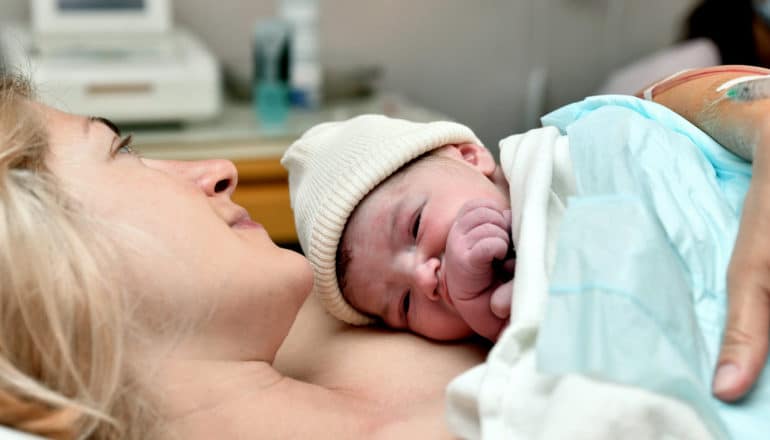
“Kangaroo care,” the practice of holding babies using skin-to-skin contact, is safe and beneficial for babies born with congenital heart defects, a new study shows.
This kind of holding—between a baby wearing just a diaper and a parent with a bare chest—has scientifically proven physiological benefits for infants, researchers say. They’re less likely to intermittently stop breathing. Their heart rate and blood sugar are less likely to drop to dangerous levels. Their body temperature is better regulated, and for mothers who want to breastfeed, this connection helps facilitate the transition to direct breastfeeding.
Yet kangaroo care isn’t always standard practice, particularly for sick infants.
“Just because your baby has a heart defect doesn’t mean that your baby shouldn’t have the opportunity to benefit from things that other babies benefit from.”
“We’ve been doing skin-to-skin at the Children’s Hospital of Philadelphia (CHOP) for more than 20 years,” says Diane Spatz of Penn’s School of Nursing and CHOP. “It’s commonplace in our neonatal intensive care unit. The Cardiac Center was slower to embrace this technique.”
For a new study, Amy Jo Lisanti, a nurse scientist at CHOP, examined kangaroo care as a method to reduce stress and facilitate parent-child bonding for babies with congenital heart disease. Lisanti, also a clinical nurse specialist at CHOP, began developing strategies to increase use of kangaroo care in the Cardiac Center, including an eight-week Kangaroo-a-Thon resulting in dozens of skin-to-skin interactions.
The new paper, published in MCN: The American Journal of Maternal/Child Nursing, shows that it’s safe and effective to incorporate skin-to-skin care into the treatment of newborns with congenital heart disease. Beyond that, they argue it should become a standard of care.
“Just because your baby has a heart defect doesn’t mean that your baby shouldn’t have the opportunity to benefit from things that other babies benefit from,” Spatz says. “Babies with cardiac defects should be held skin to skin, and mothers should be encouraged to do kangaroo care. And if the goal is to breastfeed, this is critical to helping mothers on that journey.”
Though decades of research confirm the advantages of such contact for newborns, integrating it into a care unit that hasn’t traditionally done it can pose a challenge, particularly one with high patient volume.
So, in the Cardiac Center, Lisanti created a Kangaroo Care Quality Improvement Team that educated nursing staff, wrote a new nursing policy and procedure around the practice, and adapted the electronic health record to include a space for documenting this kind of care.
The Center held its first Kangaroo-a-Thon for eight weeks in the fall of 2018. Twenty-six nurses initiated skin-to-skin contact 43 times for 14 patients. Although the study didn’t measure patient outcomes, anecdotally, the experience was positive for children and nurses alike.
“The whole idea is to get everyone—parents, families, staff—comfortable with a mom at the bedside holding her baby in this way.”
“The Kangaroo-a-Thon shed light on a tool we had in our back pockets all along. Skin-to-skin is medicine our babies need to promote healing,” one nurse wrote. “It was amazing to see how my patient’s vitals really did improve,” wrote another.
“The more people you see engaging in this practice, the more other people want to engage in it,” says Spatz. “This is happening in a hospital setting, in a critical care unit, with a lot of people and equipment around. It’s not like being in the comfort of your own home.
“But the whole idea is to get everyone—parents, families, staff—comfortable with a mom at the bedside holding her baby in this way. You can do that safely and privately.”
This is true even for a newborn hooked up to equipment and tubes, she says. “Part of that is education and awareness. This is possible, and we’re able to do it safely. We just have to prepare you for that transfer. That’s the really nice thing with the Kangaroo-a-Thon. It creates that visual awareness.”
In the United States, about 40,000 children each year are born with a congenital heart defect, approximately 1% of babies. Incorporating this small addition into their care could make a big difference, Spatz says.
Source: Penn
The post ‘Kangaroo care’ is good for babies with heart defects appeared first on Futurity.
from Futurity https://ift.tt/2PveTuR
No comments:
Post a Comment